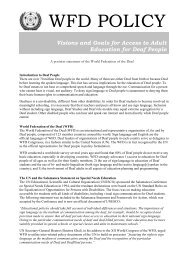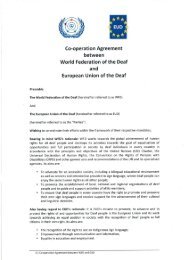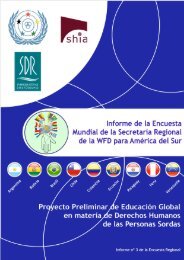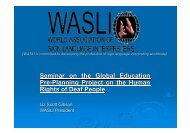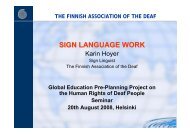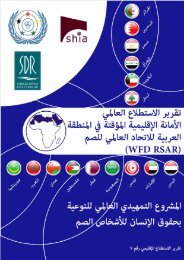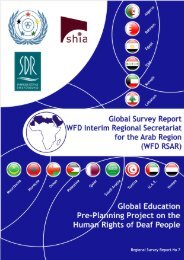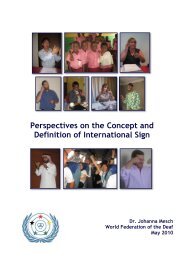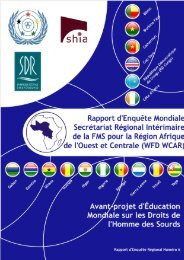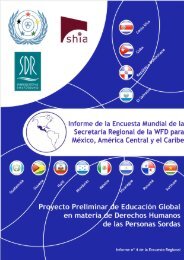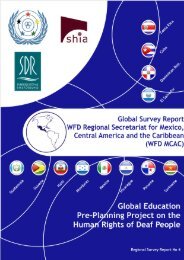RSA/P Regional Survey Report No 2 (English Version) PDF - World ...
RSA/P Regional Survey Report No 2 (English Version) PDF - World ...
RSA/P Regional Survey Report No 2 (English Version) PDF - World ...
Create successful ePaper yourself
Turn your PDF publications into a flip-book with our unique Google optimized e-Paper software.
4.1.4 Background of the Country Respondents<br />
Ten out of 14 country respondents (Australia, Indonesia, Japan, Malaysia, Nepal, New Zealand, Philippines, Korea, Sri Lanka and<br />
Thailand) are Ordinary Members (OMs) of WFD and were established between 1946 to 1997; the oldest National Association in<br />
WFD <strong>RSA</strong>/P is the one of the Republic of Korea, which was established in 1946, with the most recently-established being the one<br />
in the Philippines (1997).<br />
Four country respondents, Bhutan, Cambodia, Laos and Myanmar are not Ordinary Members of WFD, although Cambodia is an<br />
Associate Member. Information supplied from these countries was from a Deaf School (Bhutan), a Deaf Programme (Cambodia)<br />
and Deaf Groups (Laos and Myanmar).<br />
All ten OMs have their own organisational statutes/constitutions and all are recognised by their country’s government as the<br />
association representing Deaf people. Three of the four non-member respondents (Bhutan, Cambodia and Laos) stated their<br />
country’s government recognised their organisation; only in Myanmar is the Deaf Group not yet recognised by the current<br />
government.<br />
All ten WFD OMs described their organisational charts; a brief overview of their structures is:<br />
• Most of the Associations hold an annual General Assembly Meeting although some hold a General Meeting every two<br />
years<br />
• A large number of the Associations handle their own affairs and run annual meetings with their local regional members<br />
Two non-members (Cambodia and Laos) provided organisational backgrounds; Cambodia is planning to create a foundation for a<br />
national association of Deaf people.<br />
A full explanation of the organisational structures is provided on page 44.<br />
Six of the 14 country respondents (Australia, Japan, Malaysia, Nepal, New Zealand and Thailand) outlined clear policy<br />
statements in the areas of:<br />
• Sign Language<br />
• Interpreting<br />
• Human Rights of Deaf People<br />
• Educational Settings for Deaf Youth<br />
• Deaf Culture/Deaf Awareness<br />
• Cochlear Implants<br />
Other country respondents have not developed policy statements or did not provide this information.<br />
Only ten of the country respondents outlined the six highest priority issues or actions in their strategy action plans; the most<br />
common issues being:<br />
• Deaf Education<br />
• Sign Language<br />
• Sign Language Interpreters<br />
• Advocacy<br />
• Social Services<br />
• Deaf Culture/Deaf Awareness<br />
• Information Technology/Telecommunications<br />
• Employment/Vocational Training<br />
• Deaf Women<br />
• Deaf Community Development<br />
• Information Resources<br />
The questions then focused on numbers of <strong>Regional</strong> and Local Deaf Associations in each country. The largest number of <strong>Regional</strong><br />
Deaf Associations is in the Republic of Korea (146) and the largest number of Local Deaf Associations is in Indonesia (69). New<br />
Zealand does not have either <strong>Regional</strong> or Local Associations.<br />
Eight of ten WFD OMs supplied information about the number of board members of their Association. The number of board<br />
members ranges between seven and 25; Japan has the largest number with 25 members on the board. Indonesia did not supply<br />
this information. Of the non-members, only Laos has a Deaf Unit under the auspices of the Lao Disabled People’s Association of<br />
the Ministry of Labour and Social Welfare; there are five Deaf members in this Unit.<br />
One question specifically asked for the number of Deaf people serving as a member on the national board. Eight of nine country<br />
respondents (Australia, Japan, Laos, Nepal, New Zealand, Philippines, Sri Lanka and Thailand) have 100% Deaf people on the<br />
board. Malaysia has the least number of Deaf people on the board, with eight out of nine members being Deaf. The general<br />
average of Deaf people serving as a board member in countries in WFD <strong>RSA</strong>/P is 99%.<br />
Another question queried the number of Deaf women serving on boards. Australia has five Deaf women out of a total of seven<br />
board members (71%) and Japan has the smallest female representation with two out of 25 members being women (8%). Only<br />
The Project was under the auspices of the Swedish National Association of the Deaf (SDR) and the <strong>World</strong> Federation of the Deaf (WFD), Page <strong>No</strong> 14<br />
and funded by the Swedish Agency for International Development Cooperation (Sida) and Swedish Organisations of Disabled Persons<br />
International Aid Association (Shia).



